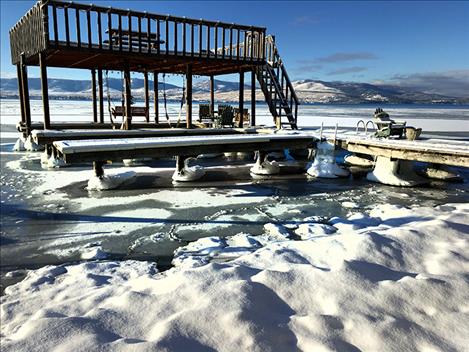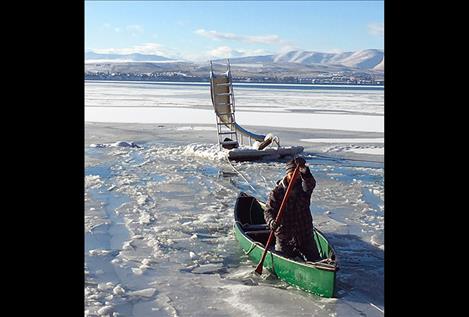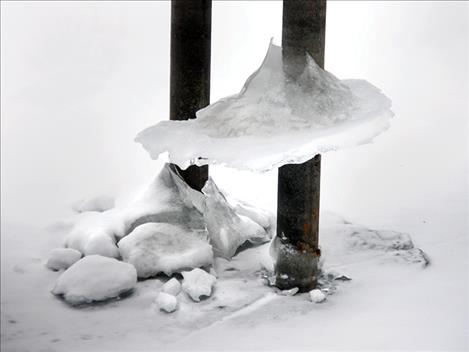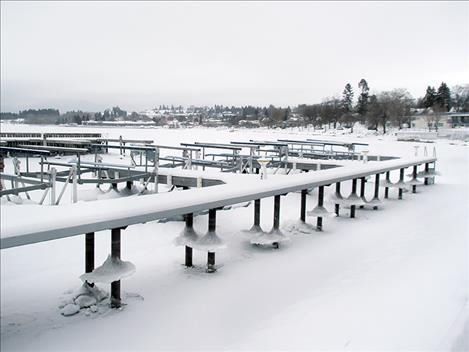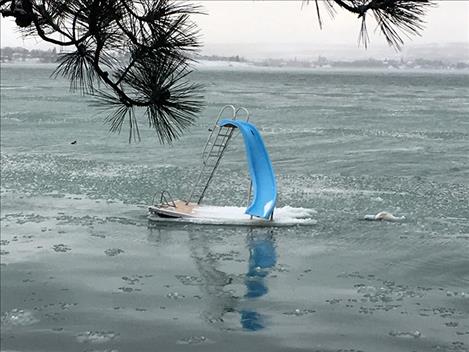What's up dock?
Lake now at normal level, lakeshore residents deal with dock ice
Hey savvy news reader! Thanks for choosing local.
You are now reading
1 of 3 free articles.
POLSON — After being as high as four feet above normal in recent months, causing ice to freeze to docks, the water level in Flathead Lake is now normal.
That’s the word from Energy Keepers Chief Executive Officer Brian Lipscomb.
Heavy rains in the Flathead Basin in October resulted in the lake level being three feet above normal that month and four feet above normal in November, he said, noting it rained for 28 days straight in the basin in October.
The towns of Hungry Horse and West Glacier had their wettest Octobers on record last year, he said. Heavy rains helped fill up Hungry Horse Reservoir and water releases there impacted Flathead Lake.
“October is usually a dry month. We usually draw the lake down two feet (then),” Lipscomb said.
In spite of the heavy rainfall and routine maintenance being performed on one of three turbines at the Selis Ksanka Qlispe Dam, Energy Keepers was able to release 9,000 cubic feet of water per second in October, Lipscomb said. The average for that month is 6,000 square feet per second. Maintenance on the turbine lasted about 60 days during October and November, he said.
The dam also released 9,000 cubic feet per second in November and between 12,000 and 13,000 cubic feet per second in December, he said. Both releases were above average for those months although lake levels remained higher than average.
The receding water levels in the lake over the past month or so has left a significant amount of ice on area docks.
Polson resident Aphia Fisher said that she and her husband, Justin, worked half a day to bring their floating dock to shore in early December.
The couple usually bring the dock to shore in the fall but didn’t do that because the water level was too high, she said. When they finally went to rescue it, the dock was surrounded by ice. Justin went onto the lake in a canoe and used a paddle and shovel to free the dock. Then Aphia pulled it to shore with a rope an inch at a time while Justin stood on it and pushed the ice away.
Aphia said the dock was “like a giant iceberg.”
Her grandfather purchased the property in 1952, she said, and she spent time in and around the lake while growing up. She doesn’t remember seeing as much ice on the docks before, she said, adding that they also have a permanent dock near the shore that is still covered with ice.
Randy Walton, owner of Dockmasters in Polson, said most dock owners are used to dealing with ice and know how to handle it. Some use sledge hammers to break it up before it damages their docks. Walton recommends using a chain saw.
“Ice tends to move toward the water as it lowers. You’ll certainly get some damage” when that happens, he said.
“This lake is so unforgiving, we get a lot of damage anyway. People tend to underestimate this lake,” he said. “In 15 to 20 minutes you can go from a dead calm to 5- to 6-foot waves.”
The people who’ve been here a long time know about the ice, but out-of-state owners might not know about the damage unless they hire a caretaker, Walton said.
As of Jan. 2, the lake level was at 2,888 feet, right at the average level for January, Lipscomb said.
Energy Keepers will be releasing 14,000 cubic feet per second throughout the month of January, and Lipscomb noted that the average is 9,750 for the month.
Lipscomb has been CEO at Energy Keepers since December 2012. The Confederated Salish and Kootenai Tribes took over ownership of the former Kerr Dam on Sept. 5, 2015 from NorthWestern Energy.















